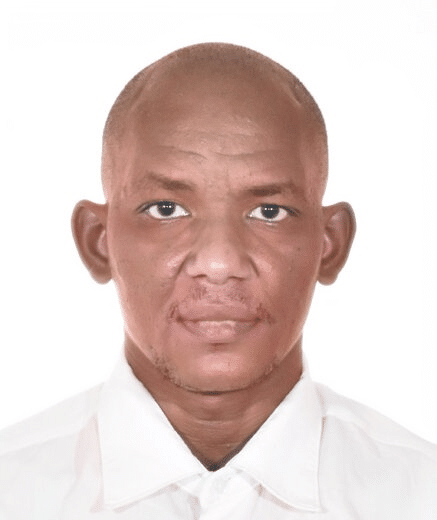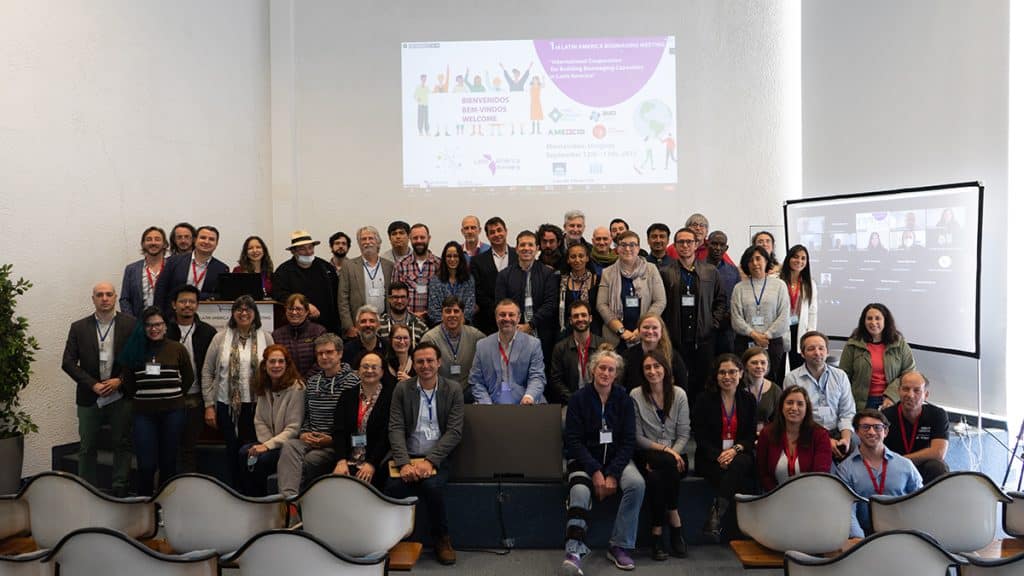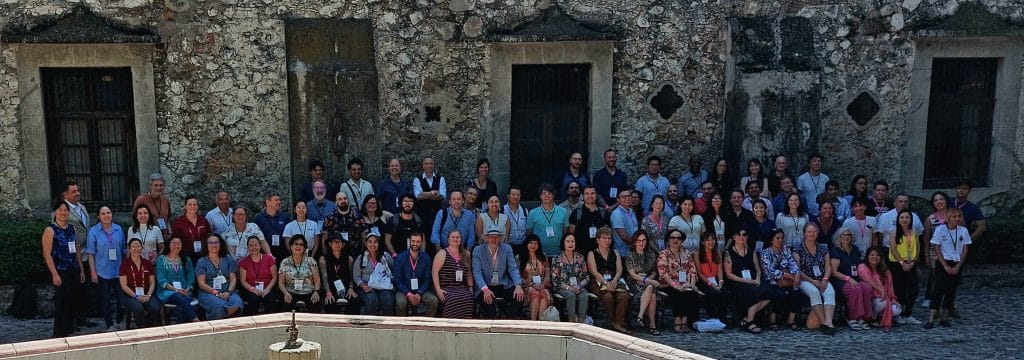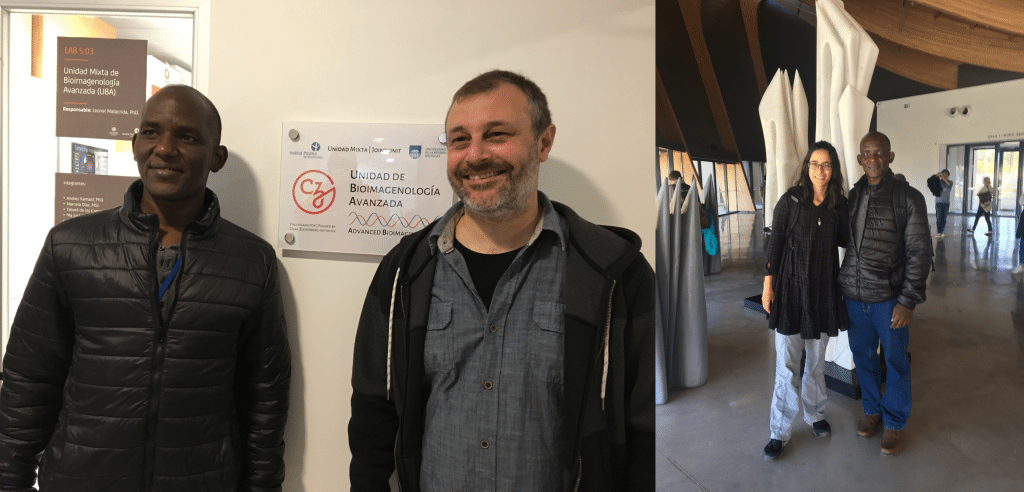An interview with Esley Torres
Posted by Mariana De Niz, on 2 July 2024

MiniBio: Esley Torres began his career in Cuba, and is currently a postdoctoral scientist and lecturer at Universidad de la República, in Montevideo, Uruguay. Esley began his undergraduate studies in Chemistry and changed directions to pursue an undergraduate degree in Mathematics at the University of Havana, Cuba. He worked at the Institute of Cybernetics, Mathematics and Physics (ICIMAF for its name in Spanish), and at the Polytechnic Jose Antonio Echeverria (also known as CUJAE). It was during his early career that Esley discovered his passion for Mathematics applied to image processing. Following this passion, Esley then went on to pursue his MSc at Universidad Autonoma del Estado de Morelos in collaboration with the Institute of Biotechnology and LNMA, and his PhD degree which he carried out at LNMA in Mexico, in the team of Adan Guerrero. Here, he worked on mean shift super resolution (MSSR), a new algorithm which extends spatial resolution of single fluorescence images beyond the diffraction limit of light. Esley has participated in multiple international training events and is committed to improving accessibility to knowledge related to image analysis.
What inspired you to become a scientist?
Before I went on to pursue my degree in Mathematics, I studied Chemistry. I studied all the way to 3rd year of the Chemistry degree, and realized I’m a really bad bench scientists doing analytical chemistry. Mixing reagents and doing measurements was just not for me. In fact there was an experiment which our teachers could tell if you had done wrong, because your hands would turn ‘carmelita’ colour (your hands would turn dark brown). So, in my 3rd year I decided I wanted to study Mathematics instead. I audited the class for one year and then I joined. My grandfather had a woodshop so, since I was very young, I was already building things and calculating things, so maybe the interest arose from there.
You have a career-long involvement in microscopy, after studying Mathematics. Can you tell us a bit about what inspired you to choose this path?
When I was in my 2nd year of the degree of Mathematics, I visited the ICIMAF Institute (Instituto de Cibernetica de Matematicas y Fisica). They do lots of different things with Mathematics. There I met Roberto Rodriguez, who later became my mentor in Cuba, and he told me about his work on Mathematics applied to image analysis. I became interested in this. I quickly felt I belonged in this discipline. That’s where I first learned about mean shift (the basis for MSSR for super-resolution). When I applied to UAEM in Mexico to do my Masters degree, we already had established a link with Adan Guerrero. My MSc focused on image processing for tracking sperm cells. I was going to do my PhD on a similar topic – sperm cells and actin, but at some point Adan organized a seminar at the Laboratorio Nacional de Microscopia Avanzada (LNMA), where I presented my work on mean shift, and Adan quickly noticed that this could be useful for an algorithm for super-resolution. So we wrote a proposal together, and that’s how MSSR came to be! We recently published our paper in Nature Communications 🙂 This has been very beneficial work, because not everyone in our region has access to instrumentation that can achieve super-resolution. MSSR is a computational tool for super-resolution.

You are now a postdoctoral fellow at Universidad de la República. What does your day-to-day look like?
I am now in Uruguay addressing a key issue. The issue with MSSR is that it’s very slow. Despite us having done several optimizations through programming, it’s still too slow for it to perform in real time. So in my postdoc with Federico Lecumberry I’m trying to simulate MSSR with a neural network- specifically a PINN (Physics Informed Neural Network). That’s one of the things I do. Another thing I work on is that using a uniform kernel, we can do MSSR in the Fourier space, so we programmed this in MatLab in one dimension, and was able to do MSSR 20-fold faster. I imagine that if we were to program it in Java or C or Python, it would be not only much faster but also more accessible. So I’m doing a neural network, and I have proposed a project that would allow people to do this in the Fourier space. I’m trying to convince students to join me in this project! The other thing is that when you apply MSSR many times, if you have fluorophores that have lower intensity than others, they start disappearing. We are working on determining what intensity the fluorophores must have in order for them not to disappear entirely. I’m loving my work in Uruguay but I must say the winters are pretty hard! I’m not used to these freezing temperatures, which neither Cuba nor Mexico have.
You’ve had great mobility in Latin America! How have you enjoyed this?
I love it, but mobility itself has been difficult many times. Imagine! I have a Cuban passport, so I need visas for everywhere in Latin America, while most other Latin Americans don’t. Last year, I was planning to participate in an event focusing on Artificial Intelligence in Argentina, and I didn’t get a visa, which was very sad. This year I will be able to attend! The solution in Mexico would have been a visa that allows permanent residence status, but this is tricky: you can’t get permanent residence status under a student visa. In order to get permanent residence, you need a formal job offer, but a formal job offer cannot be done if you don’t have permanent residence… so it’s a vicious cycle. Added to this is the massive amount of paperwork and inefficient bureaucracies. You request documents, and they take forever to arrive.


In addition to your research projects, I know that Federico Lecumberry is also heavily involved in outreach and projects that promote inclusion and integration of disciplines. Are you also involved in this?
Absolutely. Within IMAGINA and CICADA, he leads courses such as PIMBIO (Processing of Images for Biology and Medicine), MAPIO and QuMBIA (Quantitative Methods for Bioimage Analysis). PIMBIO is mostly Fiji/ImageJ covering topics from tracking to MSSR. MAPIO focuses on neural networks and deep learning. Here we cover Ilastik which is great for classification and segmentation of biological images.
Can you tell us a bit about what you have found uniquely positive about becoming a researcher in Cuba, from your education years?
At the level of administration, the organization and teaching of courses is top notch in Cuba, as is the level of teaching. For instance, there is excellent organization about the scheduling, course content, distribution of lecturers, evaluation of lecturers, etc. The lectures are monitored, and student attendance is heavily controlled too. For instance, I did my social service for two years at Politecnico Jose Antonio Echeverria (CUJAE), in Havana, Cuba. It’s the top institution in Cuba for technology-related careers. After this, I went back to ICIMAF but got hired at CUJAE as a lecturer- that’s why I know about their level of organization and monitoring for the lecturers too. As a lecturer, you get audited, and there are visitors constantly in your class, from the University administration to observe and give you feedback on how you teach courses. In Mexico I was a lecturer at Universidad Politecnica del Estado de Morelos for 2 semesters. What you get evaluated for is the demo class, but after this, there is no monitoring of your performance. So for instance, if the teacher is not good, or decides to give random grades, no one is doing careful checks of this situation. In Uruguay I am now teaching too -I’m working as an Assistant Professor, and there I’ve seen a different thing. In Cuba, as a teacher, you need to have careful control of student attendance. If the student fails to attend at least 80% of lectures, they are forbidden from attending the final tests. The professor has that right, and this guarantees that students attend. In Uruguay this control doesn’t exist. But this was my experience in specific institutions. I’m not sure if this extends to the entire education system. I just noticed that my experience in Cuba versus Mexico and Uruguay was very different.
Aside from your experience in Cuba, Mexico and Uruguay, did you have many opportunities to interact with other Latin American groups? I imagine this has increased for you, especially being so close to the LABI headquarters now?
It’s been great! My work with Adan Guerrero and Chris Wood was a wonderful experience. After our paper came out, we have been able to work with more collaborators. I think 3-4 people cannot work on a huge publication like the one we did. I love being able to work with a big team and to interact with more scientists in Latin America. Fortunately, the teams I have worked with are very collaborative so I benefit from this team spirit and connections!

Who are your scientific role models (both Cuban and foreign)?
Roberto Rodriguez, my mentor in Cuba, is one of them. What I like about his is that he’s very enthusiastic, and he was very good at publishing and making things available to the scientific community. He wasn’t interested in big papers that take forever, but rather, constant output. I loved this enthusiasm. Adan Guerrero is another role model. He has many talents – among the top is what we call ‘el don de la palabra’ – the gift of the word, aka the power of convincing people. I don’t know how he does it, but he’s great at it. He knows a lot and he knows how to sell ideas. I’m sure there are other role models. There are different things I admire in different people: enthusiasm, convincing power, depth of knowledge. Among people I have never met, but whose work I admire is Ricardo Henriques. He has lots of ideas, he’s very creative and has had a huge impact on the imaging and image analysis world. I think he might be speaking at the Superres meeting in Rio de Janeiro, but I won’t be able to attend because of visa issues.
You’ve had a chance of training young scientists all the time. Is this something you enjoy? What is the best part about this?
Here in Uruguay, at the end of your undergraduate degree, you need a project that lasts more or less a month. You have to do some small research project. I have proposed my MSc thesis (tracking of sperm cells, for which I have tons of videos), and MSSR. The idea is that they track sperm cells, or program MSSR. Last year the project on sperm cells got picked and this year the MSSR project got picked so I’m very happy. The idea is for them to re-program MSSR on Python, which is what everyone likes nowadays, and if they like the idea, the can continue with the questions about Fourier. Anyway, all that to say, I love teaching. It’s very rewarding.
What is your opinion on gender balance in Cuba, given current initiatives in the country to address this important issue. How has this impacted your career?
With the PIMBIO and MAPBIO courses, we are 4 of us teaching the course, and all of us are men. But among the Biologists and MDs, there are a lot of women. In the engineering faculty here in Uruguay, most students and teachers, are men. There is not much gender balance. It’s been a similar experience for me everywhere. But with Federico’s efforts, for the courses we taught, among the participants, there were more women than men – that was my impression at least, but I’d have to double check the statistics. So, baby steps. We’ll get there.
Are there any historical events in Cuba that you feel have impacted the research landscape of the country to this day?
We have the Academy of Sciences of Cuba – they give national awards to institutions. At ICIMAF they used to celebrate different achievements and they would organize events that would bring together scientists from all the provinces of Cuba. Other than this, I can’t really tell.
Have you faced any challenges as a foreigner if you have worked outside Cuba?
The first challenge in Mexico was how spicy the food is! Gosh! I then had to get used to the accent, but this wasn’t a big deal. No, but on a more serious note, the first real challenge was to leave Cuba, when I went to Mexico: to legalize the documents and get the paperwork, you must pay a huge amount of money. The apostille for the documents is about 500 USD, but this is a HUGE amount of money in Cuba. Fortunately, I got a loan, and when I was awarded the scholarship, I was able to pay it back. Other than this, doing a PhD thesis is always a big challenge: the research is difficult, the writing is difficult, but above all, you know what was really difficult for me? Writing the acknowledgements 🙂 The possibility that you might accidentally leave someone out is terrifying, especially because they are in writing. Now in Uruguay, the challenge I’m facing is that neural networks is something new for me, so it’s exponential learning curve. And then everyone is programming in Python – it’s booming now. And I don’t know how to code in Python very well – I always miss some package or something simple. So, while for most people it’s very easy, because I’ve been programming in very different languages, getting used to this new one is not so straightforward.
What is your favourite type of microscopy and why?
From microscopy, I’ve mostly worked on processing fluorescence images. For instance, I have never processed EM images – I have little experience in this field. I enjoy image processing, regardless of the image though.
What is the most extraordinary thing you have seen by microscopy? A eureka moment for you?
During my undergraduate degree, one subject I liked a lot was topology. My experience in my degree in Mathematics was that you start with numbers and then some letters start appearing. Eventually the numbers start slowly disappearing and become letters. I eventually realized that Mathematics is a degree of letters 🙂 you have to demonstrate lots of things. Topology, which is taught in 3rd year, needs a lot of abstraction. If you start imagining things only, you’re in the wrong path: you have to demonstrate things due to their properties and what you can write in paper, not due to what you can imagine. I loved this completely. In terms of my postdoc, having learned from Roberto about mean shift, helped me a lot to work on MSSR. When I realized this was working was when I programmed the mean shift in one dimension. This is when I figured out the property fulfillment related to the Sparrow and Rayleigh limits. About 3 years ago I was stuck on the writeup of one of my projects: the mean shift in the Fourier space. I had the formulae in front of me and I didn’t know how to interpret them. Eventually something came to my mind and once in Uruguay I better understood and could better decipher what the different things meant. I discussed with Paul and Adan that I didn’t quite understand everything.
What is an important piece of advice you would give to future Cuban scientists? and especially those specializing as microscopists?
I’m terrible at giving advice….
Where do you see the future of science and microscopy heading over the next decade in Cuba, and how do you hope to be part of this future?
Cuba has very few resources. It’s a difficult life, and it’s difficult to do science. For now I see my future in Uruguay. Had I been able to resolve the issue of residence in Mexico, I would have stayed there. It’s a lovely country. But Mexico is tough for visas anyway. Uruguay is easier in this respect: less people and life is great. In terms of my own work and my own contributions, I want to keep working on MSSR. I’d love to apply MSSR to images of astronomy and I want to decipher more about neural networks. That’s my future.
Beyond science, what do you think makes Cuba a special place to visit? Or other places you’d like to visit?
I think in the future, I want to go to China – to the temple of Wudang. But I don’t like the cold. Regarding other places I’d love to visit: I’d love the opportunity to do an internship with Ricardo Henriques. I’d love to spend some time in his lab, and I’d love to see Portugal. I’d also love to spend some time in Italy, in the lab of Alvaro Crevenna.


 (No Ratings Yet)
(No Ratings Yet)
